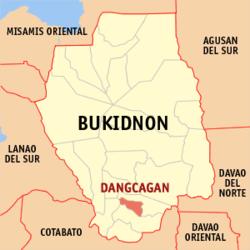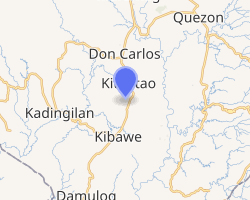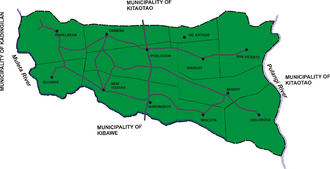Dangcagan, Bukidnon
Dangcagan, officially the Municipality of Dangcagan (Cebuano: Lungsod sa Dangcagan; Tagalog: Bayan ng Dangcagan), is a 3rd class municipality in the province of Bukidnon, Philippines. According to the 2015 census, it has a population of 23,723 people.[3]
Dangcagan | |
|---|---|
| Municipality of Dangcagan | |
 Seal | |
 Map of Bukidnon with Dangcagan highlighted | |
OpenStreetMap 
| |
.svg.png) Dangcagan Location within the Philippines | |
| Coordinates: 7°37′N 125°00′E | |
| Country | |
| Region | Northern Mindanao (Region X) |
| Province | Bukidnon |
| District | 3rd district of Bukidnon |
| Barangays | 14 (see Barangays) |
| Government | |
| • Type | Sangguniang Bayan |
| • Mayor | Fruto B. Dandasan Jr. |
| • Vice Mayor | Edilberto F. Ayuban |
| • Congressman | Manuel F. Zubiri |
| • Electorate | 17,007 voters (2019) |
| Area | |
| • Total | 422.69 km2 (163.20 sq mi) |
| Population (2015 census)[3] | |
| • Total | 23,723 |
| • Density | 56/km2 (150/sq mi) |
| • Households | 5,163 |
| Economy | |
| • Income class | 3rd municipal income class |
| • Poverty incidence | 43.13% (2015)[4] |
| • Revenue (₱) | 117,230,263.00 (2016) |
| Time zone | UTC+8 (PST) |
| ZIP code | 8719 |
| PSGC | |
| IDD : area code | +63 (0)88 |
| Climate type | tropical rainforest climate |
| Native languages | Western Bukidnon language Binukid Cebuano Ata Manobo Tagalog |
| Website | www |
History
Dangcagan used to be an abode of the Manobos under the leadership of Datu Dangaan (meaning “to praise”), a prominent chieftain ruler known for his courage and affluence. The place was then a little Sitio of Maramag. As the Christian settlers from Luzon & Visayas began to flock and settle in the area. Datu Dangaan followers ran and hide their families in the forest and returned to their home only when they knew the settlers were not around.
This leads the settler to call the “Dagandagan”. It took ample time for the settler to befriend the natives. When the natives and the Christian settlers finally united, they made representation to the Municipal Government of Maramag to form a regular barrio within the territory of Datu Dangaan. They agreed to call the barrio Dangcagan in honor of the natives.
The first set of officers was headed by Mayor Vicente Cabiling, originally appointed to the position in 1961 and was elected and served for ten (10) consecutive years, he constructed the old Municipal Hall on top of the hill in the poblacion. And from 1972 until March 1986 Mayor Fruto Ll. Dandasan assumed the office. During his time he constructed new roads and maintained the barangay road network of Dangcagan
In 1992, Mayor Norberta B. Dandasan assumed as Municipal Mayor until June 1995. She pursued the programs and projects that were initiated by her late husband and other predecessors. The municipal gymnasium was completed.
In the May 1995 election, Roberto Cabunoc took over the mayorship of the town and implemented the road concreting projects, beautification of the municipal plaza, installation of water system, construction of the new municipal hall and completion of different barangay projects. After three terms of Mayor Cabunoc, Mayor Edilberto F. Ayuban followed with 3 consecutive terms.
In the mayoral election of 2013, Mayor Fruto B. Dandasan who used to be one of the town's elected councilor, became the town vice mayor for two consecutive terms and now elected as the municipal mayor of the town.
Geography
Dangcagan is located in the southern part of the province. It is 72 kilometres (45 mi) from the provincial capital, Malaybalay City, and 162 kilometres (101 mi) from regional center, Cagayan de Oro City, which is the main outlet for its agricultural products. The town is sandwiched by municipality of Kitaotao in the northern and eastern part, by Kibawe, in its southern part and by Kadingilan on its western part. The Pulangi River and Muleta River serves as its natural boundary with Kitaotao (eastern side) and Kadingilan (western side), respectively.
The municipality has an aggregate land area of more or less 42,269 hectares (104,450 acres).
Climate
It has distinct dry and wet season; the wettest Month is usually September and the driest month is March.
| Climate data for Dancagan, Bukidnon | |||||||||||||
|---|---|---|---|---|---|---|---|---|---|---|---|---|---|
| Month | Jan | Feb | Mar | Apr | May | Jun | Jul | Aug | Sep | Oct | Nov | Dec | Year |
| Average high °C (°F) | 28 (82) |
28 (82) |
29 (84) |
31 (88) |
30 (86) |
29 (84) |
28 (82) |
29 (84) |
29 (84) |
29 (84) |
29 (84) |
29 (84) |
29 (84) |
| Average low °C (°F) | 20 (68) |
20 (68) |
20 (68) |
21 (70) |
22 (72) |
22 (72) |
22 (72) |
22 (72) |
22 (72) |
22 (72) |
21 (70) |
20 (68) |
21 (70) |
| Average precipitation mm (inches) | 44 (1.7) |
27 (1.1) |
32 (1.3) |
35 (1.4) |
76 (3.0) |
117 (4.6) |
108 (4.3) |
108 (4.3) |
94 (3.7) |
100 (3.9) |
76 (3.0) |
46 (1.8) |
863 (34.1) |
| Average rainy days | 10.3 | 8.1 | 8.5 | 9.6 | 21.0 | 24.9 | 25.0 | 24.2 | 22.5 | 23.4 | 17.7 | 11.4 | 206.6 |
| Source: Meteoblue (modeled/calculated data, not measured locally) [5] | |||||||||||||
Soil and topography
It has a fertile soil ranging from clay to sandy loam. Its topography is 70% flat and 30% rolling, which is suitable for agricultural crops such as corn, rice and other commercial crops like coconut, coffee, cacao, rubber, banana and sugar cane.
Barangays

Dangcagan is politically subdivided into 14 barangays.
| PSGC | Barangay | Population | ±% p.a. | |||
|---|---|---|---|---|---|---|
| 2015[3] | 2010[6] | |||||
| 101303001 | Barongcot | 9.2% | 2,192 | 2,006 | 1.70% | |
| 101303002 | Bugwak | 2.8% | 653 | 596 | 1.75% | |
| 101303003 | Dolorosa | 4.8% | 1,134 | 1,015 | 2.13% | |
| 101303004 | Kapalaran | 6.3% | 1,503 | 1,458 | 0.58% | |
| 101303005 | Kianggat | 7.0% | 1,654 | 1,527 | 1.53% | |
| 101303006 | Lourdes | 2.7% | 636 | 749 | −3.07% | |
| 101303007 | Macarthur | 3.5% | 822 | 802 | 0.47% | |
| 101303008 | Miaray | 15.2% | 3,607 | 3,268 | 1.90% | |
| 101303009 | Migcuya | 4.6% | 1,094 | 1,075 | 0.33% | |
| 101303010 | New Visayas | 4.2% | 995 | 977 | 0.35% | |
| 101303011 | Osmeña | 6.3% | 1,487 | 1,383 | 1.39% | |
| 101303012 | Poblacion | 25.1% | 5,956 | 5,782 | 0.57% | |
| 101303013 | Sagbayan | 4.6% | 1,093 | 1,019 | 1.34% | |
| 101303014 | San Vicente | 3.8% | 897 | 791 | 2.42% | |
| Total | 23,723 | 22,448 | 1.06% | |||
Demographics
| Year | Pop. | ±% p.a. |
|---|---|---|
| 1970 | 13,464 | — |
| 1975 | 13,386 | −0.12% |
| 1980 | 13,652 | +0.39% |
| 1990 | 14,823 | +0.83% |
| 1995 | 16,660 | +2.21% |
| 2000 | 18,857 | +2.69% |
| 2007 | 21,254 | +1.66% |
| 2010 | 22,448 | +2.01% |
| 2015 | 23,723 | +1.06% |
| Source: Philippine Statistics Authority[3][6][7][8] | ||
In the 2015 census, the population of Dangcagan was 23,723 people,[3] with a density of 56 inhabitants per square kilometre or 150 inhabitants per square mile.
Languages and dialects
The majority of the municipality's inhabitants speak Cebuano, although some inhabitants also speak the Hiligaynon/Ilonggo language and many still speak Binukid (Manobo language).
References
- "Municipality". Quezon City, Philippines: Department of the Interior and Local Government. Retrieved 31 May 2013.
- "Province: Bukidnon". PSGC Interactive. Quezon City, Philippines: Philippine Statistics Authority. Retrieved 12 November 2016.
- Census of Population (2015). "Region X (Northern Mindanao)". Total Population by Province, City, Municipality and Barangay. PSA. Retrieved 20 June 2016.
- "PSA releases the 2015 Municipal and City Level Poverty Estimates". Quezon City, Philippines. Retrieved 12 October 2019.
- "Dancagan: Average Temperatures and Rainfall". Meteoblue. Retrieved 29 April 2020.
- Census of Population and Housing (2010). "Region X (Northern Mindanao)". Total Population by Province, City, Municipality and Barangay. NSO. Retrieved 29 June 2016.
- Censuses of Population (1903–2007). "Region X (Northern Mindanao)". Table 1. Population Enumerated in Various Censuses by Province/Highly Urbanized City: 1903 to 2007. NSO.
- "Province of Bukidnon". Municipality Population Data. Local Water Utilities Administration Research Division. Retrieved 17 December 2016.